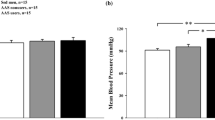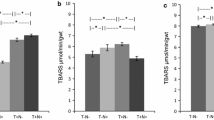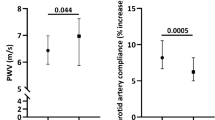Abstract
Androgenic steroids administered in doses at pharmacological levels to sedentary animals have been shown to result in a reduced β-adrenoceptor-mediated increase in systolic cardiac performance when assessed in vivo. Whether the attenuated adrenergic response occurs as a consequence of alterations in either cardiac loads, heart rate, modifications in left ventricular (LV) geometry, or a decrease in myocardial contractile performance has not been determined. In this study the effect of chronic administration (over 3 months) of an androgenic steroid (nandrolone decanoate, 5 mg · kg−1 biweekly) on the response of load-insensitive indices of myocardial contractile function [the slope of the LV systolic stress-strain relationship (LV-En max, where En max is systolic myocardial elastance)] to an adrenergic-inotropic stimulus was examined ex vivo in paced rat hearts. Systolic cardiac performance was assessed at 300 beats · min−1 in isolated constant flow perfused heart preparations both before and during 10−8.5 mol · l−1 isoproterenol (ISO) infusion (approximate concentration of ISO eliciting 50% maximal inotropic response to ISO). Steroid administration resulted in left-shifted LV systolic and diastolic pressure-volume (P-V ) relationships. The leftshifted P-V relationships were attributed, in part, to increased slopes of these relationships. However, the steroid-mediated increment in the slope of the systolic P-V relationship (systolic chamber elastance, Emax) was not associated with a similar change in LV En max [control 19.2 (SEM 2.1) g · cm−2, steroid 18.3 (SEM 2.4) g . cm−2] as determined in the absence of ISO. Isoproterenol infusion resulted in an increase in both Emax and En max in the control rats, without altering systolic performance in the steroid treated rats. Consequently, in the presence of ISO, the steroid treated rats exhibited a similar Emax, but a reduction in En max compared to the control rats [control 25.6 (SEM 1.9) g · cm−2, steroid 18.5 (SEM 1.5) g · cm−2; P < 0.05]. In conclusion, these results would suggest that chronic high dose androgenic steroid administration produces a decrease in myocardial contractile reserve to β-adrenoceptor stimulation.
Similar content being viewed by others
Author information
Authors and Affiliations
Additional information
Accepted: 3 September 1999
Rights and permissions
About this article
Cite this article
Norton, G., Trifunovic, B. & Woodiwiss, A. Attenuated β-adrenoceptor-mediated cardiac contractile responses following androgenic steroid administration to sedentary rats. Eur J Appl Physiol 81, 310–316 (2000). https://doi.org/10.1007/s004210050048
Issue Date:
DOI: https://doi.org/10.1007/s004210050048




